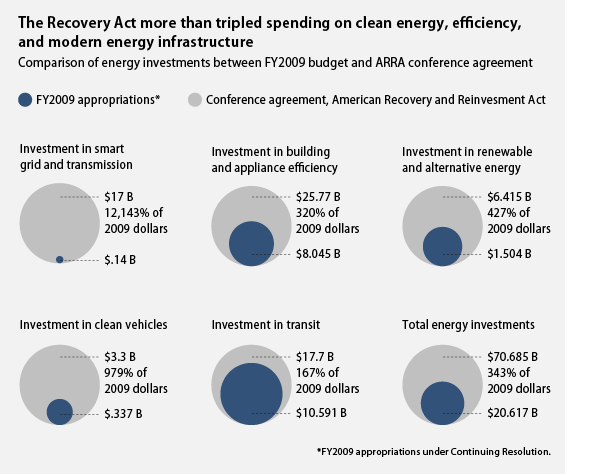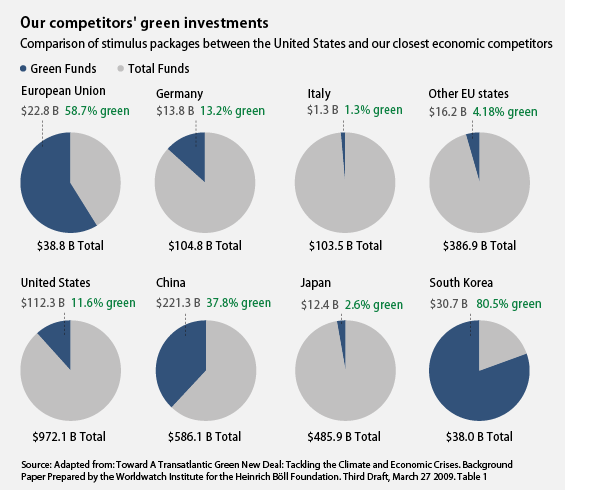If the American Recovery and Reinvestment Act (ARRA) had been an energy bill, it would arguably have been the single-most important piece of clean energy legislation in our nation’s history. It drove unprecedented new investments — both public and private — into modernizing America’s clean energy infrastructure. And its clean energy provisions alone have already saved or created 63,000 jobs and are expected to create more than 700,000 jobs by 2012. Now that ARRA has run its course, we need to stay committed to these investments to keep building the U.S. clean energy industry and remain globally competitive.
Newly elected President Barack Obama signed the historic economic recovery package into law two years ago this week. ARRA was an emergency measure to “stop the bleeding” from the worst economic downturn since the Great Depression, which the new president inherited from the previous administration.
Two years later we can confidently say ARRA has worked. Broadly supported by industry and economists, ARRA infused $787 billion into our nation’s economy. It created investments, saved and created more than 3 million American jobs, softened the blow of the global economic collapse on unemployed workers, sustained the ability of hard-hit cities and states to keep vital public services afloat, and buffered countless American companies from the worst of the malaise.
But there is another less heralded — though in many ways equally important — story to be told about the Recovery Act: its boost to clean energy.
ARRA served over the last two years to sustain the fledgling American clean technology industry at a time when it was hard hit by economy-wide contractions in capital investment and struggling to remain globally competitive in the absence of a clear national energy policy. ARRA provided financing tools and signaled clear demand to investors. This helped U.S. businesses rebound, got new projects built, and put Americans back to work.
Clean energy technology now remains one of the fastest-growing sectors of the global economy and it is projected to grow to $2.3 trillion by 2020. ARRA committed more than $80 billion for the development and deployment of clean energy, and with this initial investment it has set a course for this country to compete with rising nations such as China, whose scale of investment in energy innovation dwarfs our own. China’s policy commitments position them to play a dominant role in emerging global clean energy markets.
A Center for American Progress comparison of ARRA investments in clean energy to what had originally been planned in the 2009 budget reveals that the Recovery Act more than tripled spending on innovative clean energy, efficiency, and modern energy infrastructure (see table below). For some technologies — such as smart grid investments — ARRA represented more than a 1,000 percent increase in clean energy innovation.

Contrary to conservative attacks — which are too often funded by fossil-fuel industries that seek to slow the pace of change — ARRA made substantial gains to our economy and activated a growing industry with its best years yet to come. With two years of hindsight, we can clearly see ARRA was in fact the most important investment in clean energy ever achieved by an American president.
A quick review of the facts:
- ARRA’s clean energy provisions alone have already saved or created 63,000 jobs and are expected to create more than 700,000 jobs by 2012.
- More than 300,000 low-income homes have been upgraded with energy-saving weatherization, saving families on average more than $400 on their heating and cooling bills in the first year alone and $161 million in energy costs nationwide.
- ARRA provided $500 million in funds for green job training that is already helping prepare workers to transition into the new economy — many in some of the hardest-hit regions of the recession.
- Inner-city green jobs have grown by 11 percent — more than 10 times the rate of job growth overall.
- A guarantee for a $1.3 billion loan has been finalized to support the world’s largest wind farm right here in America.
- ARRA helped American motorists retire their gas-guzzling “clunkers” as well as help transition the U.S. auto industry to produce new electric cars and advanced batteries and retool assembly lines to make more fuel-efficient vehicles.
- Other measures such as the Treasury grant program (section 1603) proved essential to companies in financing new renewable energy projects, driving the industry’s rebound during the Recovery Act period.
- The Recovery Act’s investments of $80 billion for clean energy will produce as much as $150 billion in clean energy projects due to leveraging private investment.
These achievements are impressive. But they should be considered building blocks in a global industrial revolution. They are an essential part of the bigger picture: making America globally competitive in the 21st century with a stronger, better clean energy economy.
The Recovery Act’s purpose was to get the economy moving again, but through smart leadership it also helped move the economy in the right direction. It laid the foundation for a clean, innovative, and more efficient low-carbon energy future. It is a credit to the president and Congress that they recognized the historic importance of these one-time investments and directed the stimulus toward activities that anticipated the need for forward vision in a changing economy.
Clearly, our closest economic competitors understand the strategic importance of investing in more efficient and innovative infrastructure. China, for example, had a recovery package smaller than ours but invested at more than double the American rate. It spent $12.6 million every hour on clean energy in its stimulus. The story is even more pronounced in South Korea, which made greening their energy infrastructure a centerpiece of their economic competitiveness strategy (see table below).

Right now, the United States is transitioning its energy infrastructure from capital-intensive, dirty energy sources to clean, innovation-intensive, and job-creating clean energy sources. The unprecedented investment and leadership ARRA provided has accelerated this transition and laid an essential foundation for continued business growth and a sustained period of market innovation.
But these processes won’t continue on their own. Without clear policy commitments to clean energy, the United States risks ceding its gains and falling dangerously behind its competitors. We’ve made progress but these green seedlings of an emerging industry must be protected and cultivated to reach their full potential for driving domestic economic growth.
We must seize the leadership opportunity in this sector. The president should use the power of his office in the budget process, and through all executive agencies, to catalyze the market with clear and forward-looking policies that send a signal of commitment and stability to the private sector and continue to drive investment.
In the absence of these steps, the United States will see an exodus of firms and capital to countries that are bold enough to take action — namely Europe, China, and other emerging markets. Time and time again, U.S. private-sector firms lament a lack of clear and consistent policy on clean energy. This stymies investment and slows job creation.
What we need today is another Telecom Act, which used regulatory reform, tax policy, and public investment to drive the growth of entirely new private industries. This will pick up where the Recovery Act’s clean energy investments left off.
Congress’s to-do list, therefore, should include passing legislation that encourages research and development, provides needed capital to help breakthrough technologies reach the commercialization stage, and allows for the construction of necessary electric grid improvements to carry renewable energy.
To that end, Congress should expand and extend the Advanced Energy Manufacturing Tax Credit. It should also create new mechanisms for finance such as a Clean Energy Deployment Administration to promote early-phase commercialization of technologies and an Energy Independence Trust to fuel commercial deployment of mature technologies at scale.
Congress also needs to clearly define how new transmission infrastructure will be built to serve renewable electricity resources, set standards for smart grid technologies, and find a permanent solution to the challenge of using tax credits in project financing for renewable energy and energy efficiency in the built environment.
Further, a target of meeting 35 percent of all electricity needs by 2035 through energy efficiency and truly renewable energy sources — including wind, solar, geothermal, and wave technologies — would boost investors’ certainty that there will be a market for these sources. This number should constitute a floor, not a ceiling, for growth.
President Obama called for a surge of innovation and growth to be America’s next “Sputnik moment.” ARRA made an important down payment on this goal but it will take the collective will of policymakers and private-sector investment to prevail. On this two-year anniversary of the Recovery Act, we should look back with satisfaction that we have seen the American clean energy industry through a rough period in the global economy. But this is no time to rest on our laurels. The rest of the world will not wait for America to catch up. There is work to be done and America must lead the way.



